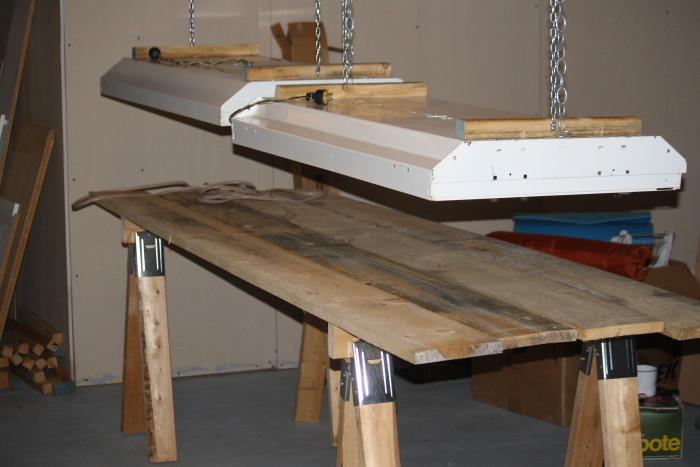The geraniums that I potted up nearly two weeks ago are finally starting to show signs of growth. The following photo shows baby leaves popping out all over. I had taken plants that had hung dormant in my basement for four months, cut the stems to about four inches, cutting out completely any stems that were obviously dead and cutting the roots back severely leaving a small plant with little obvious signs of life. It is always a challenge for me to see how many of these plant remnants survive and thrive. Last year the survival rate was 80 per cent – it will be significantly lower this year but for me this method of overwintering geraniums is still preferable to maintaining potted geraniums in window sills all winter.
It is time to start indoor seeding in earnest. Timing is all important – currently we are about 11 weeks away from the May 24 outdoor planting date for frost-sensitive plants. Peppers and eggplant can grow for ten weeks indoors and be healthy vigorous plants ready to plant in the garden in late May. On the other hand tomatoes need a maximum of eight weeks; otherwise they will be huge ungainly plants long before it is time to plant them in the garden. Celery, parsley, onions, leeks and globe artichokes also benefit from a ten to 12 week head start indoors. When I mention the number of weeks growing indoors this is calculated by counting backwards from the time that the seedlings can be planted in the garden. If my goal is to have onions and leeks in the garden by the first of May and parsley and celery planted a week or two later (they have some frost hardiness so can be planted in the garden considerably before the May 24 frost-free date) then the calculation results in an indoor seeding date of mid-February (but don’t despair if you don’t have them planted yet – plants are flexible).
The key to growing seedlings successfully indoors is lots of light. If plants don’t have enough light they will be spindly and weak and will not be able to handle the transition to outdoor conditions. Even a very sunny window is unlikely to provide sufficient light given the number of cloudy days in winter – I have found that it is much more reliable to start seedlings under artificial light. It is also likely to get very cool at night close to the window.
The set-up does not need to be fancy. The following photo shows a growing table made out of some rough planks, a few two-by-fours and saw-horse brackets and a couple of fluorescent fixtures suspended by chains so that I can adjust them to keep them within a couple of inches of the seedlings. Used fluorescent fixtures are available for next to nothing at garage sales. I use only the cheapest four-foot fluorescent tubes as my results have been just as good as using special “grow” tubes. The lights are on a timer to give the plants an eight hour nightly rest period. I water only when the growing medium is dry to the touch but before the seedlings wilt and drain off any excess water that has not been absorbed in a couple of hours.
 Seeds contain all the nutrients required for germination. I use a diluted organic fish-based fertilizer weekly after seedlings have been growing for a couple of weeks.
Seeds contain all the nutrients required for germination. I use a diluted organic fish-based fertilizer weekly after seedlings have been growing for a couple of weeks.
Seedlings are very vulnerable to certain kinds of viral diseases, commonly called ‘damping –off’. Seedlings that appear healthy topple over from the base and die. I have found that this is virtually eliminated by using a commercial soil-less mixture (I generally buy a bag of this from Carleton Place Nursery who make their own mix) and new plastic inserts (I use 10 inch by 20 inch plastic trays with a 32, 48 or 76 pot insert). I also insure good air circulation by keeping an oscillating fan running constantly. The air movement also produces stronger, stockier plants.
I fill the pots with my seeding mixture, plant one or two seeds in each pot (following directions on the packet as to seeding depth), and then cover with a clear plastic ‘green-house’ lid (which I remove as soon as the seed has germinated). Celery, celeriac and parsley are planted in 76 cell inserts, artichoke in 32 cell inserts, and onions and leeks in recycled Styrofoam boxes (they can tolerate much closer growing conditions and transplant easily). And of course the job is not done until the paperwork is finished – I make charts of all my trays and use some labels in the pots as well – onions and leeks look very similar when they start growing as do parsley, celery and celeriac.
The vegetable seeds that I have sown over the last week or so are starting to show some activity as shown in the following photo. This year I have already seeded onions, leeks, parsley, globe artichoke, celery, celeriac, lettuce, broccoli, mizuna, mustard and kale. I have sown the greens considerably ahead of the time that I would regularly sow them. This is because I, along with some fellow gardeners, have been given access to a hoop house (basically an unheated greenhouse). We will be learning about the different timing for planting hardy greens in a hoop house. I find the whole concept of extending the gardening season by several months an exciting one and will be reporting on this initiative as the season proceeds.
A major event for vegetable gardeners is being held March 7th from 10 to 3 in Ottawa at Britannia Park (Ron Kolbus Lakeside Centre) – called Seedy Saturday it is a jam-packed auditorium full of vendors of heritage seeds, a seed exchange table, some yummy locally baked goods, presentations on gardening and booths by organizations such as the Ottawa Community Gardening Network and the Canadian Organic Growers. Last year at 10 am there was a line-up of people at the doors waiting for them to open and by afternoon it was so crowded that it was almost impossible to move (let alone find a space in the parking lot).
There is also a similar event in Perth on March 8th from 10 to 3 at the Royal Canadian Legion. I must admit that I prefer this venue as there is not the same need to elbow through the crowds.
The first Neighbourhood Tomato pot-luck was held Monday March 2 – I hope that you were there! I will be reporting on more Neighbourhood Tomato plans and activities on a regular basis.
Currently the Almonte Library in partnership with the Neighbourhood Tomato is offering a series of four vegetable growing workshops. On February 21, I had the pleasure of leading a workshop of over 30 enthusiastic gardeners on starting and growing cool-weather vegetables. On Saturday March 7 Master Gardener Gerda Franssen will be leading a workshop on hot-weather vegetables. We will be leading a couple more workshops March 28 and April 11. Seating is limited so if you wish to attend please register first with Library staff.




